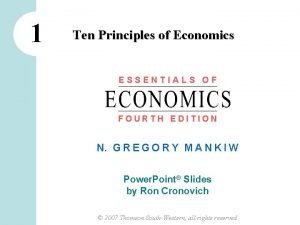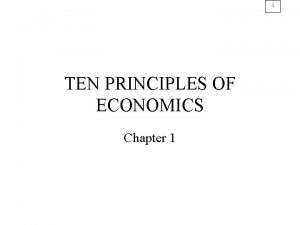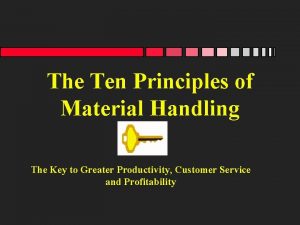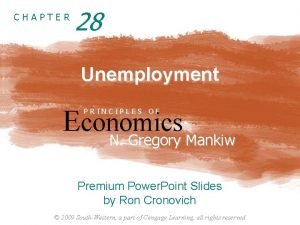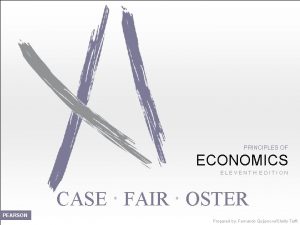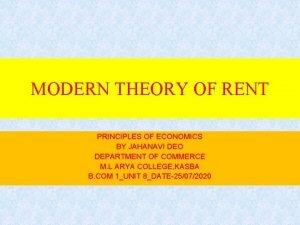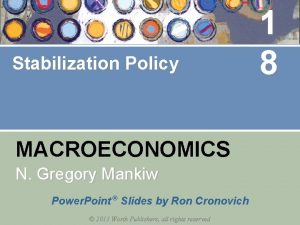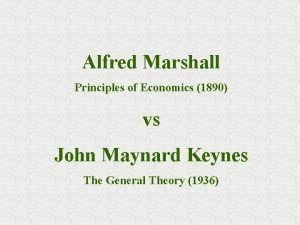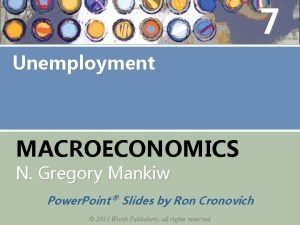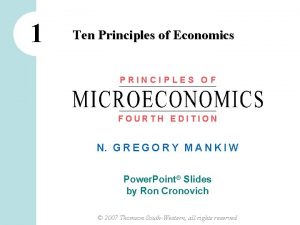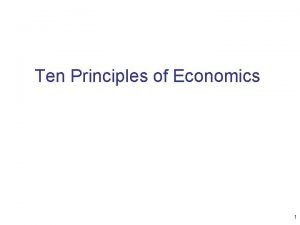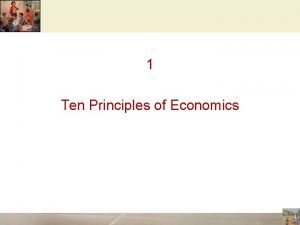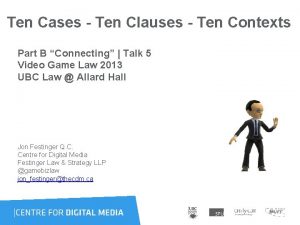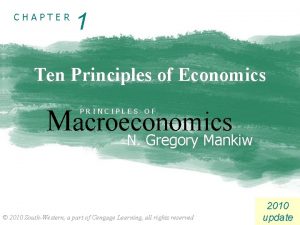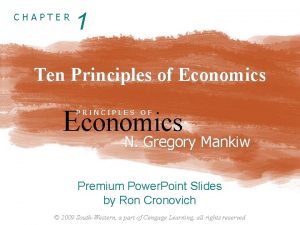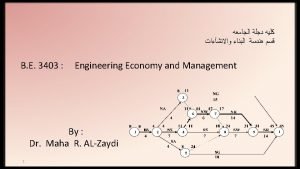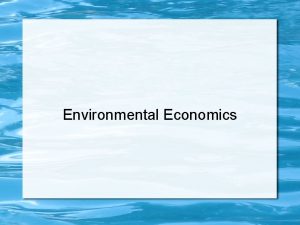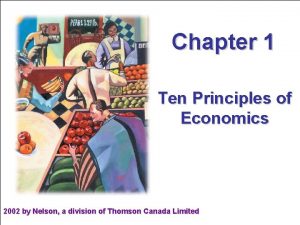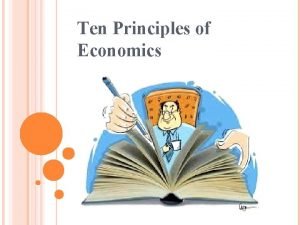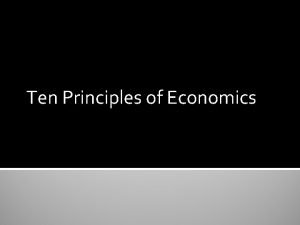1 Ten Principles of Economics PRINCIPLES OF FOURTH





















- Slides: 21

1 Ten Principles of Economics PRINCIPLES OF FOURTH EDITION N. G R E G O R Y M A N K I W Premium Power. Point® Slides by Ron Cronovich 2008 update © 2008 South-Western, a part of Cengage Learning, all rights reserved

HOW PEOPLE MAKE DECISIONS Principle #1: People Face Tradeoffs All decisions involve tradeoffs. Examples: § Going to a party the night before your midterm leaves less time for studying. § Having more money to buy stuff requires working longer hours, which leaves less time for leisure. § Protecting the environment requires resources that could otherwise be used to produce consumer goods. CHAPTER 1 TEN PRINCIPLES OF ECONOMICS 1

HOW PEOPLE MAKE DECISIONS Principle #1: People Face Tradeoffs § Society faces an important tradeoff: efficiency vs. equity § efficiency: getting the most out of scarce resources § equity: distributing prosperity fairly among society’s members § Tradeoff: To increase equity, could redistribute income from wealthy to poor. But this reduces incentive to work and produce, shrinks the size of the economic “pie. ” CHAPTER 1 TEN PRINCIPLES OF ECONOMICS 2

HOW PEOPLE MAKE DECISIONS Principle #2: The Cost of Something Is What You Give Up to Get It § Making decisions requires comparing the costs and benefits of alternative choices. § The opportunity cost of any item is whatever must be given up to obtain it. Examples: The opportunity cost of… …seeing a movie is not just the price of the ticket, but the value of the time you spend in theater. CHAPTER 1 TEN PRINCIPLES OF ECONOMICS 3

HOW PEOPLE MAKE DECISIONS Principle #3: Rational People Think at the Margin § A person is rational if she systematically and purposefully does the best she can to achieve her objectives. § When making decisions, rational consumers and businesspeople evaluate the costs and benefits of marginal changes – incremental adjustments to an existing plan. CHAPTER 1 TEN PRINCIPLES OF ECONOMICS 4

HOW PEOPLE MAKE DECISIONS Principle #3: Rational People Think at the Margin Examples: § A student considers whether to go to college for an additional year, comparing the fees & foregone wages to the extra income he could earn with an extra year of education. § A firm considers whether to increase output, comparing the cost of the needed labor and materials to the extra revenue. CHAPTER 1 TEN PRINCIPLES OF ECONOMICS 5

HOW PEOPLE MAKE DECISIONS Principle #4: People Respond to Incentives § incentive: something that induces a person to act, i. e. the prospect of a reward or punishment. § Rational people respond to incentives. Examples: • When gas prices rise, consumers buy more hybrid cars (e. g. , Toyota Prius). • When cigarette taxes increase, teen smoking falls. CHAPTER 1 TEN PRINCIPLES OF ECONOMICS 6

ACTIVE LEARNING Exercise 1: You are selling your 1996 Mustang. You have already spent $1000 on repairs. At the last minute, the transmission dies. You can pay $600 to have it repaired, or sell the car “as is. ” In each of the following scenarios, should you have the transmission repaired? A. Blue book value is $6500 if transmission works, $5700 if it doesn’t B. Blue book value is $6000 if transmission works, $5500 if it doesn’t 7

ACTIVE LEARNING Answers 1: Cost of fixing transmission = $600 A. Blue book value is $6500 if transmission works, $5700 if it doesn’t Benefit of fixing the transmission = $800 ($6500 – 5700). It’s worthwhile to have the transmission fixed. B. Blue book value is $6000 if transmission works, $5500 if it doesn’t Benefit of fixing the transmission is only $500. Paying $600 to fix transmission is not worthwhile. 8

ACTIVE LEARNING Answers 1: Observations: § The $1000 you previously spent on repairs is irrelevant. What matters is the cost and benefit of the marginal repair (the transmission). § The change in incentives from scenario A to scenario B caused your decision to change. 9

HOW PEOPLE INTERACT Principle #5: Trade Can Make Everyone Better Off § Rather than being self-sufficient, people can specialize in producing one good or service and exchange it for other goods. § Countries also benefit from trade & specialization: • get a better price abroad for goods they • produce buy other goods more cheaply from abroad than could be produced at home CHAPTER 1 TEN PRINCIPLES OF ECONOMICS 10

HOW PEOPLE INTERACT Principle #6: Markets Are Usually A Good Way to Organize Economic Activity § Market: a group of buyers and sellers § “Organize economic activity” means determining • what goods to produce • how to produce them • how much of each to produce • who gets them § In a market economy, these decisions result from the interactions of many households and firms. CHAPTER 1 TEN PRINCIPLES OF ECONOMICS 11

HOW PEOPLE INTERACT Principle #6: Markets Are Usually A Good Way to Organize Economic Activity § The invisible hand works through the price system: • The interaction of buyers and sellers determines prices. • Each price reflects the good’s value to buyers and the cost of producing the good. • Prices guide self-interested households and firms to make decisions that, in many cases, maximize society’s economic well-being. CHAPTER 1 TEN PRINCIPLES OF ECONOMICS 12

HOW PEOPLE INTERACT Principle #7: Governments Can Sometimes Improve Market Outcomes § Important role for govt: enforce property rights (with police, courts) § People are less inclined to work, produce, invest, or purchase if large risk of their property being stolen. CHAPTER 1 TEN PRINCIPLES OF ECONOMICS 13

HOW PEOPLE INTERACT Principle #7: Governments Can Sometimes Improve Market Outcomes § market failure: when the market fails to allocate society’s resources efficiently § Causes: • externalities, when the production or consumption of a good affects bystanders (e. g. pollution) • market power, a single buyer or seller has substantial influence on market price (e. g. monopoly) § In such cases, public policy may promote efficiency CHAPTER 1 TEN PRINCIPLES OF ECONOMICS 14

HOW PEOPLE INTERACT Principle #7: Governments Can Sometimes Improve Market Outcomes § Govt may alter market outcome to promote equity § If the market’s distribution of economic well-being is not desirable, tax or welfare policies can change how the economic “pie” is divided. CHAPTER 1 TEN PRINCIPLES OF ECONOMICS 15

ACTIVE LEARNING Discussion Questions 2: In each of the following situations, what is the government’s role? Does the government’s intervention improve the outcome? a. Public schools for K-12 b. Workplace safety regulations c. Public highways d. Patent laws, which allow drug companies to charge high prices for life-saving drugs 16

HOW THE ECONOMY AS A WHOLE WORKS Principle #8: A country’s standard of living depends on its ability to produce goods & services. § The most important determinant of living standards: productivity, the amount of goods and services produced per unit of labor. § Productivity depends on the equipment, skills, and technology available to workers. § Other factors (e. g. , labor unions, competition from abroad) have far less impact on living standards. CHAPTER 1 TEN PRINCIPLES OF ECONOMICS 17

HOW THE ECONOMY AS A WHOLE WORKS Principle #9: Prices rise when the government prints too much money. § Inflation: increases in the general level of prices. § In the long run, inflation is almost always caused by excessive growth in the quantity of money, which causes the value of money to fall. § The faster the govt creates money, the greater the inflation rate. CHAPTER 1 TEN PRINCIPLES OF ECONOMICS 18

HOW THE ECONOMY AS A WHOLE WORKS Principle #10: Society faces a short-run tradeoff between inflation and unemployment § In the short-run (1 – 2 years), many economic policies push inflation and unemployment in opposite directions. § Other factors can make this tradeoff more or less favorable, but the tradeoff is always present. CHAPTER 1 TEN PRINCIPLES OF ECONOMICS 19

CONCLUSION Mankiw’s 10 principles translated CHAPTER 1 TEN PRINCIPLES OF ECONOMICS 20
 One of the ten principles of economics in chapter 1
One of the ten principles of economics in chapter 1 One of the ten principles of economics in chapter 1
One of the ten principles of economics in chapter 1 Ten principles of economics chapter 1
Ten principles of economics chapter 1 Fifty past nine
Fifty past nine Ten ten siempre fuerzas y esperanza
Ten ten siempre fuerzas y esperanza Am i a 10/10
Am i a 10/10 Expert systems: principles and programming, fourth edition
Expert systems: principles and programming, fourth edition School of business and economics maastricht
School of business and economics maastricht Econ213
Econ213 Ten principles of good interdisciplinary team work
Ten principles of good interdisciplinary team work Material handling principle
Material handling principle Principles of economics oxford fajar pdf
Principles of economics oxford fajar pdf Chapter 28 unemployment
Chapter 28 unemployment Principles of economics powerpoint lecture slides
Principles of economics powerpoint lecture slides Principles of economics case fair oster
Principles of economics case fair oster Features of modern theory of rent
Features of modern theory of rent Principles of economics mankiw 9th edition ppt
Principles of economics mankiw 9th edition ppt Rational people think at the margin
Rational people think at the margin Marshall keynes
Marshall keynes Principles of economics mankiw 9th edition ppt
Principles of economics mankiw 9th edition ppt The fourth pillar of islam
The fourth pillar of islam Third party vs fourth party
Third party vs fourth party

